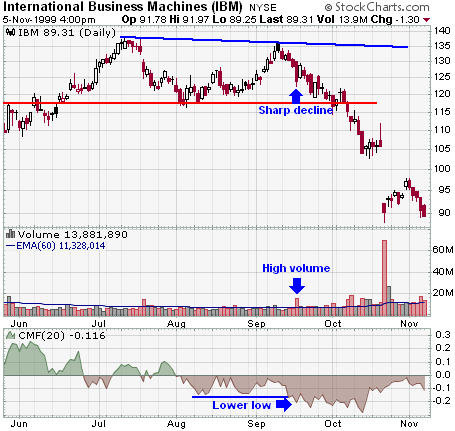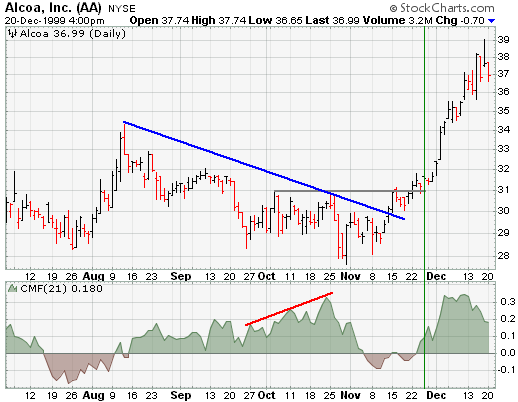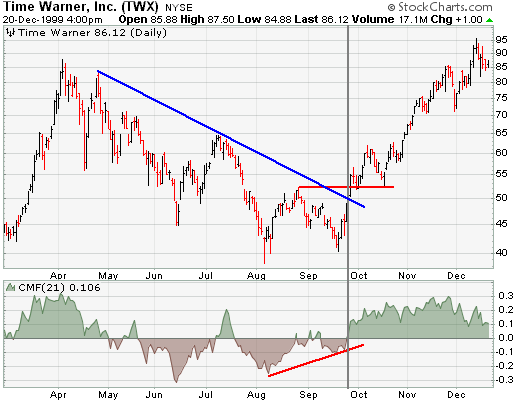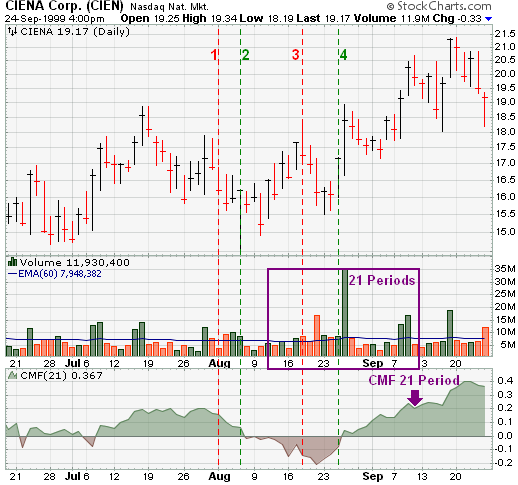http://wealthv.com/TradingStrategies/chaikin_money_flow_part_2.htm
we are computing a one day net positive or negative money flow based on whether a stock closes above or below its’ mid-point for the day, measuring how close to its’ high or low it is at the close, and then relating that to the volume.
化学反应 自由能
How is it Computed?
The following is the formula for the Chaikin Money Flow Indicator:Step 1 (((Close – Low) – (High – Close))/ (High – Low)) * Volume
Step 2 21 Day Average of Step1 (Daily MF) / 21 Day Average of Volume
In plain English we are computing a one day net positive or negative money flow based on whether a stock closes above or below its’ mid-point for the day, measuring how close to its’ high or low it is at the close, and then relating that to the volume.
By taking a 21 day average of the daily money flow and dividing that by the 21 day average volume we now have the Chaikin Money Flow Oscillator which has boundaries between + 1 and - 1 or + 100 and -100 depending on the software program.
| Chaikin Money Flow Part 2 Part 1 | Part 2 |
| Distribution Indications |
- The first and most obvious bearish signal is when Chaikin Money Flow is less than zero. A negative reading indicates that the security in question is under selling pressure or experiencing distribution.
- The second potentially bearish signal is the length of time that Chaikin Money Flow has remained negative. The longer the oscillator remains negative, the greater the evidence of sustained selling pressure or distribution. Extended periods below zero indicate that sentiment towards the underlying security is bearish and there is likely to be downward pressure on the price as well. The length of time can be determined by measuring the percentage of time that the indicator remains below zero. If Chaikin Money Flow is negative to 3 out of 4 weeks, then it would be experiencing selling pressure 75% of the time.
- The third potentially bearish signal is the degree of selling pressure or distribution. This can be determined by the oscillator's absolute level. Readings on either side of the zero line or within 10 percent of both sides (plus or minus .10) are usually not considered strong enough to warrant a bullish or bearish signal. Once the indicator moves below -.10, the degree selling pressure begins to warrant a bearish signal. (A move above .10 would be significant enough to warrant a bullish signal). Any further movement would increase the degree of selling pressure and the bearish or bullish inclination. Marc Chaikin considers a reading below -25 percent (-.25) to be indicative of strong selling pressure. Conversely, a reading above .25 is considered to be indicative of strong buying pressure. These levels are general guidelines and establishing important levels will depend on the characteristics of the individual security and past readings for Chaikin Money Flow.
J C Penny


J. C. Penny (JCP) is an example of a stock that experienced distribution for many weeks before the price actually fell. Once the price began to fall, the indicator remained in negative territory for an extended period of time. From March to May, Chaikin Money Flow had been positive (green). On 18-May, the stock gapped up on the open, but the indicator abruptly fell and turned negative (red arrows). The stock advanced intraday on the 18th, but fell by the close to end the day near the lows. Based on the previous close, the stock advanced. However, from the perspective of Chaikin Money Flow, the stock closed near the low for the day on heavy volume, which is regarded as selling pressure.
J C Penny


To prove that this abrupt change was not a fluke, the indicator declined further over the next several weeks and remained negative for almost 3 months, indicating that selling pressure was strong in the stock. Not only did the selling pressure remain for an extended period, but also the degree of selling pressure increased. Chaikin Money Flow reached a low of -.468 (negative 46.8 percent) while the stock was near its highs around 50. The stock began to confirm the selling pressure and worked its way down in June and July.
There were a few weeks in August when the indicator turned positive. This might have been seen as bullish, but it lasted a mere 3 weeks and Chaikin Money Flow only managed to get as high as +.1270. Furthermore, the price action of the stock never confirmed this strength and it is likely that other price and momentum indicators were bearish as well. The positive readings did not last long and by early September, Chaikin Money Flow was trading below -.25 and the stock was trading around 36. This was a solid signal that selling pressure in the stock remained heavy and there would likely be downward pressure on the price before long. The stock subsequently declined below 20 and Chaikin Money Flow has not been positive since late August.
All three indications of selling pressure were prevalent in JCP:
- Chaikin Money Flow turned negative before the stock declined.
- The indicator remained negative for 6 out of 7 months (85% of the time).
- Almost all of the negative readings were below -.10 and many times the indicator dipped below -.25.
IBM


IBM provides an excellent example of a reaction rally that had failure written all over it. When the stock peaked in July, Chaikin Money Flow was already well off of its highs. The indicator was still positive and mildly bullish, but could not surpass +.10 to even partially confirm the high. The indicator formed a double top in July with both peaks well below +.10. After the decline in late July, the stock began to find support and rallied in August, but Chaikin Money Flow would have none of it. The indicator broke below -.10 twice and remained negative for almost the entire month. When the stock reached its September reaction high, Chaikin Money Flow was still negative.
After the September high in the stock, things began to fall apart. On 17-Sept, the stock declined with heavy volume and Chaikin Money Flow recorded a new reaction low. Each of these items is marked with a blue arrow on the chart. By this time, selling pressure had been evident for over a month. Chaikin Money Flow had been negative the whole time and had progressively weakened. The sharp decline in the stock on the heaviest volume in over 4 months indicated something was not right. The final straw came when support at 118.5 was broken and Chaikin Money Flow was trading below -.20.
| Chaikin Money Flow and other Indicators |
Chaikin Money Flow can be used to identify the tradable trend. If Chaikin Money Flow has been above zero for most of the past three months, then prudence would dictate that the tradable trend is up. The oscillator is indicating that buying pressure prevails. It would not be sensible to attempt a short sale if the tradable trend is up. By identifying the tradable trend, traders can ignore bearish signals and only pay attention to signals that concur. If Chaikin Money Flow indicates that buying pressure prevails, then positive divergences, bullish moving average crossovers, bullish centerline crossovers and bullish oversold crossovers would be potential buy signals. (A bullish oversold crossover occurs when an indicator advances above the oversold line. This would be a move from below 30 to above 30 for RSI). All bearish signals would be ignored, at least as long as Chaikin Money Flow indicated that buying pressure reigned.
One possible combination of indicators would be the following:
- Chaikin Money Flow - A non-trend-following volume indicator to identify buying and selling pressure.
- RSI - A momentum indicator used to identify potential overbought and oversold levels.
- Moving averages - A trend-following indicator to identify the underlying trend in the stock.
- Price relative - A comparative indicator to identify the strength of the stock relative to a major index.
| Chaikin Money Flow Part 1 Part 1 | Part 2 |
| Introduction |
| Methodology |
On the CIEN chart, the purple box encloses 21 days of Accumulation/Distribution Values. The total of these 21 days divided by the total for the 21 days of volume forms the value of Chaikin Money Flow at the end of that day (purple arrow). To calculate the next day, the Accumulation/Distribution Value from the first day is removed and the value for the next day is entered into the equation.
The number of periods can be changed to best suit a particular security and timeframe. The 21-day Chaikin Money Flow is a good representation of the buying and selling pressure for the past month. A month is long enough to filter out the random noise. By using a longer timeframe, the indicator will be less volatile and be less prone to whipsaws. For weekly and monthly charts, a shorter timeframe is usually suitable.
Generally speaking, Chaikin Money Flow is considered bullish when it is positive and bearish when it is negative. The next item to assess is the length of time Chaikin Money Flow has remained positive or negative. Even though divergences are not an intricate part of the strategy behind Chaikin Money Flow, the absolute level and general direction of the oscillator can be important.
| Accumulation Indications |
- The first and most obvious signal to look for: is Chaikin Money Flow greater than zero? It is an indication of buying pressure and accumulation when the indicator is positive
- The second item: determine how long the oscillator has been able to remain above zero. The longer the oscillator remains above zero, the more evidence there is that the security is under sustained accumulation. Extended periods of accumulation or buying pressure are bullish and indicate that sentiment towards the security remains positive.
- The third indication: the actual level of the oscillator. Not only should the oscillator remain above zero, but it should also be able to increase and attain a certain level. The more positive the reading is, the more evidence of buying pressure and accumulation. There is such a thing as weak buying! This is usually a judgment call, based on prior levels for the oscillator.

On the chart for AA, Chaikin Money Flow actually strengthened while the stock continued to decline. For most of October, the stock traded flat while Chaikin Money Flow remained positive and continued to strengthen. The accumulation levels, as evidenced by Chaikin Money Flow, were very strong in October. The stock fell at the end of October and Chaikin Money Flow declined in November. When the stock fell, distribution levels never surpassed -.10, indicating that selling pressure was not that intense. In late November, the stock managed a comeback and broke resistance at 31. Chaikin Money Flow formed a higher low and returned to positive territory to confirm the breakout. Selling pressure dried up quickly and Chaikin Money Flow was able to bounce back in strong fashion. The evidence is clearly bullish, but to capitalize a trader would have had to act fast.
Time Warner

The chart for Time Warner is a bit different. The stock formed a double bottom in August and September while Chaikin Money Flow formed a rather large positive divergence. This divergence was not a signal, but would have served as an alert that the selling pressure was decreasing. Divergences can be difficult to act on and should be used in conjunction with other aspects of technical analysis. By the time the stock broke resistance at 52, Chaikin Money Flow has moved from a mildly bearish levels just above -.10 to moderately bullish levels just above +.13. The interesting point about Time Warner is the period from 28-Sept to 22-Oct (gray lines). During this period, the stock traded sideways, but Chaikin Money Flow continued to strengthen as buying pressure intensified. The oscillator moved from +.1208 on 28-Sept to +.2377 on 22-Oct. Buying pressure has nearly doubled. This was a clearly bullish indication and the stock soon obliged with an advance from the low fifties to over 90.
In Part 2, we examine how Chaikin Money Flow measures distribution or selling pressure and offer some strategies for using the oscillator with other indicators.
Part 1 | Part 2

No comments:
Post a Comment